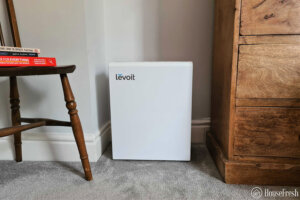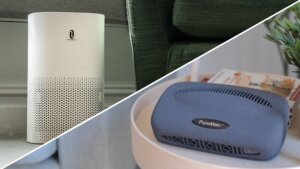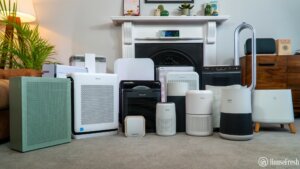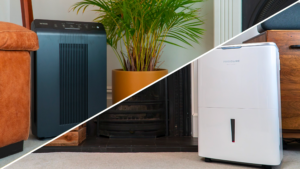If you’re trying to reduce symptoms of allergies, asthma or other respiratory conditions, you’ll want to breathe air free of pollutants and allergens. If you breathe clean air while you sleep, you should wake up feeling great.
However, it’s vital to position the air purifier correctly in your bedroom.
This article will explain how to get the most out of your air purifier. Placing it in the most efficient location can greatly reduce the pollutants you breathe in at night!
The 8 rules of bedroom air purifier placement
Rule 1: Keep it in the breathing zone


With smaller air purifiers, staying close to the breathing zone is essential. An air purifier is supposed to filter all the air in a room, purifying it with each cycle. However, with many small purifiers, like those designed to be put in bedrooms, it is beneficial to try and have them near the bed. This will ensure you breathe fresh air while you sleep, instead of air purified a while ago and have had time to pick up pollutants.
If you have limited space, look at what we think are the best wall mounted air purifiers as these can be mounted high so don’t use any floor space.
Rule 2: Place it at least three feet off the ground


Unless you have a large cleaner designed to be placed on the ground, you want yours to be at least three feet in the air. This is because air flows vertically when temperature changes, like overnight cooling. If your purifier is down on the ground, it will have difficulty catching the updrafts and downdrafts.
Rule 3: Keep away from corners


If your cleaner is pressed against a couch or bookshelf, it will have a similar effect to placing it in a corner or against a wall. Ideally, you’ll always want to maintain three feet of space, but if that isn’t possible, it’s best to allow a minimum of three inches for a small current of air to flow past.
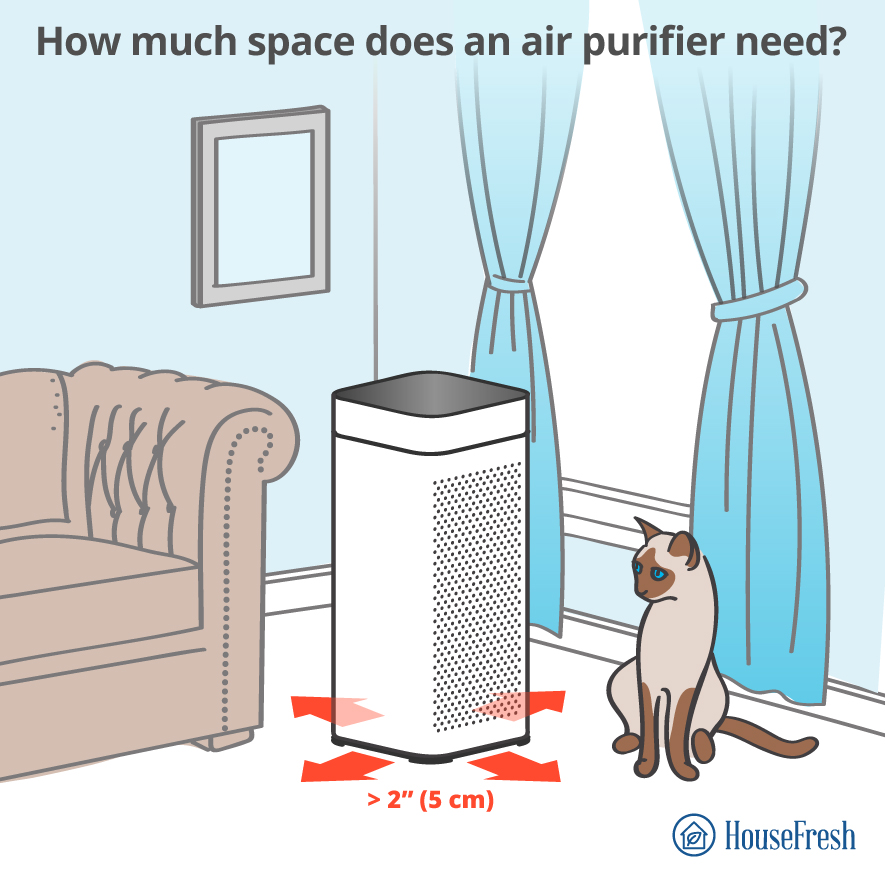
Rule 5: Capture pollutants at the source


There is likely a specific reason you bought an air purifier. Maybe there is a balcony where people smoke outside, and you want to minimize the odors that leech in through the windows.
Or, it could be that a pet sleeps in your room, or you suspect that pollutants are coming into your bedroom under the door. If you find that there isn’t a good space for the air purifier near your bed- or if the white noise produced is a little too loud- try to place it closer to the source of pollution.
Rule 6: Check where the air inlets and outlets are not blocked
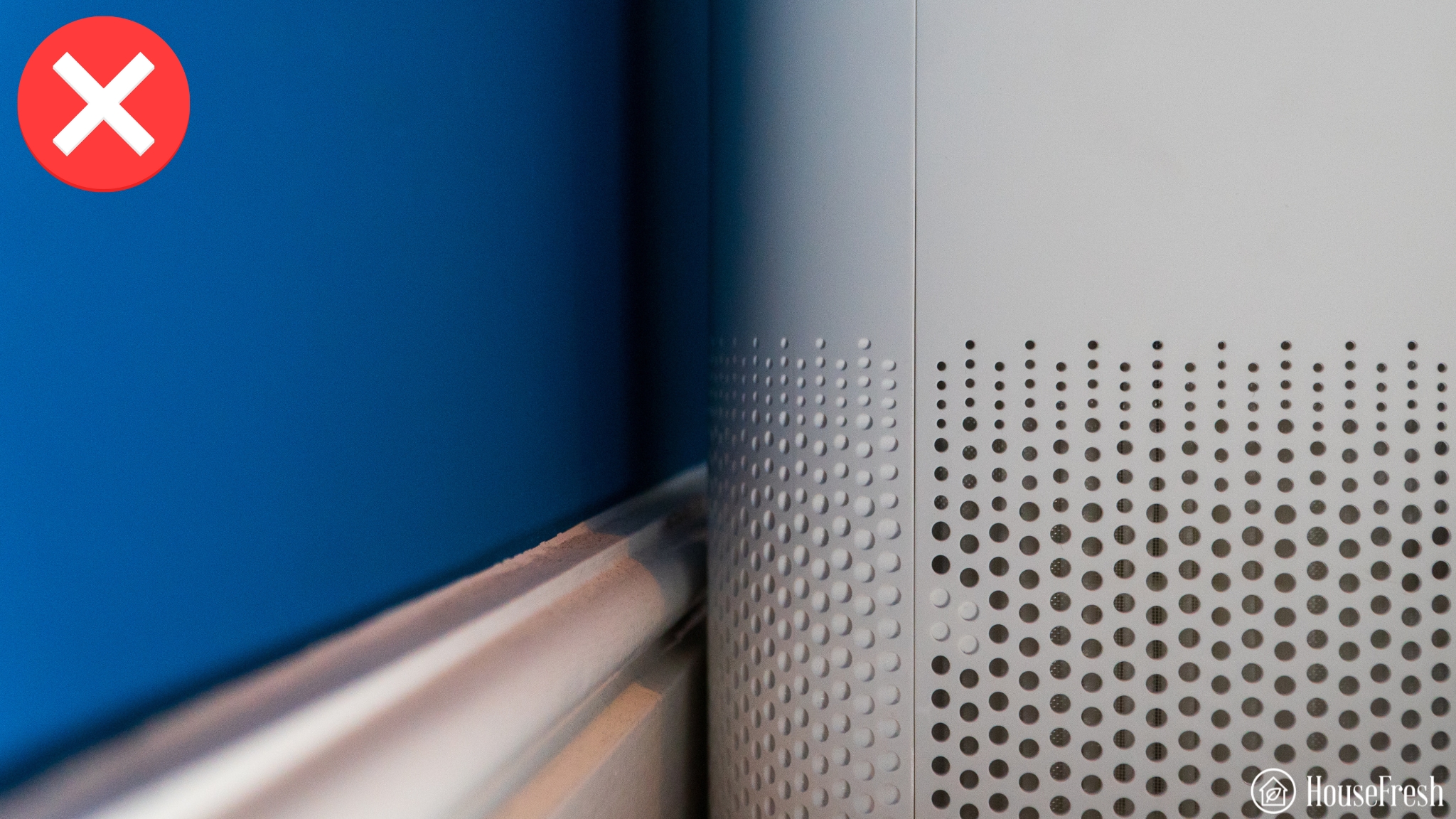

Even if your bedroom is small and without any ideal spots for an air purifier, it doesn’t mean you’re doomed to a life of waking into an allergic episode. Keep track of where the air inlets and outlets are on your particular air purifier; by doing so, you’ll be able to ensure that those sections of the machine are exposed to airflow.
You won’t get the most out of your air purifier, but at least it will still be cleaning your bedroom air!
Rule 7: Steer clear of foot traffic


Rule 8: Measure your room to buy the right air purifier
To do this, you need to know your space’s CADR (Clean Air Delivery Rate). This is the method with which you’ll be able to figure out your bedroom’s CADR score.
- Multiply the room’s length, width and height to calculate the volume of your room in feet.
- Multiply that number by four. The basis for this calculation is that the air is cleaned four times per cycle.
- Divide that number by the required cycle time. The standard cycle is one hour or sixty minutes.
Volume: 18ft length x 17ft width x 10ft height = 3000 cubic feet
Minimum CADR score:
3000 square feet x 4 air changes ÷ 60 minute cycles = 200 CADR
You will be able to see what CADR score (AKA Cubic Feet per Minute, or CFM) an air purifier has in its device specs when considering one for purchase. If an air purifier is too big for the room, you can just turn it down (or enjoy extra-clean air!).
If the air purifier has a CADR score that is slightly too low, it shouldn’t matter too much, either. It should be sufficient as long as the air purifier can clean approximately two-thirds of the air volume.
How to pick a quiet air purifier
Picking a quiet air purifier for the bedroom is extremely important. All air purifiers create a little white noise, so you need a noise level that will be comfortable for you to sleep next to. This is especially important because you want the air purifier to be as close to your breathing zone as possible in the bedroom. Ideally, you also want it to run all night long!
Air purifiers are most effective when run at their top speed, so pick one with a top speed that is comfortable to sleep next to.
Make sure to ask about the intended use of a specific air purifier.
Some are designed for loud offices, whereas others are built to run so quietly that they wouldn’t disturb even a newborn baby! Pick one that is explicitly designed for bedroom use.
If you are worried about being disturbed by the ambient noise of an air purifier, then look for one that creates pink noise rather than white. Pink noise is a more slow and more soothing ambient noise and has been shown to improve sleep quality. It blends in with background sounds instead of overwhelming them.
When looking for a quiet air purifier, try purchasing one designed as recently as possible! The technology used to reduce noise has improved significantly over the last few years.
The best bedroom air purifiers
We have compiled a short list of the top air purifiers on the market. These air purifiers are designed for use in the bedroom. They are incredibly effective, as well as being quiet and compact. Therefore, it’s easy to find a space to put them where they will be most effective! Check out our full of the best air purifiers for the bedroom.
When deciding which air purifier to use, you could do far worse than going with one of the three listed below:
Final thoughts
Choosing the right air purifier for your bedroom can help improve lung health and quality of sleep… But make sure you put it in the right place, too!
So, let’s quickly recap on where you should put an air purifier in the bedroom:
- Either use it near your bed so that you are breathing air fresh from the cleaner while you sleep, or place it near the source of pollutants you’re worried about
- Be sure to keep it a few feet away from walls, at least a few inches away from furniture— and try to keep it off the ground, too!
Don’t get too stressed out about getting it perfect. Air purifiers are well-engineered machines that do a decent job even in sub-optimal conditions.
Last update on 2024-04-22 / Affiliate links / Images from Amazon Product Advertising API



